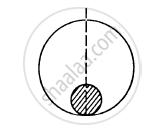Advertisements
Advertisements
Question
Suppose the gravitational potential due to a small system is k/r2 at a distance r from it. What will be the gravitational field? Can you think of any such system? What happens if there were negative masses?
Solution
The gravitational potential due to the system is given as \[V = \frac{k}{r^2}\]
Gravitational field due to the system :
\[E = - \frac{dV}{dr}\]
\[ \Rightarrow E = - \frac{d}{dr}\left( \frac{k}{r^2} \right) = - \left( - \frac{2k}{r^3} \right)\]
\[ \Rightarrow E = \frac{2k}{r^3}\]
We can see that for this system , \[E \propto \frac{1}{r^3}\]
This type of system is not possible because \[F_g\] is always proportional to inverse of square of distance(experimental fact).
If there were negative masses, then this type of system is possible.
This system is a dipole of two masses, i.e., two masses, one positive and the other negative, separated by a small distance.
In this case, the gradational field due to the dipole is proportional to \[\frac{1}{r^3}\]
APPEARS IN
RELATED QUESTIONS
Can we apply Newton’s third law to the gravitational force ? Explain your answer.
State two applications of universal law of gravitation.
Can two particles be in equilibrium under the action of their mutual gravitational force? Can three particles be? Can one of the three particles be?
Three equal masses m are placed at the three corners of an equilateral triangle of side a. Find the force exerted by this system on another particle of mass m placed at (a) the mid-point of a side, (b) at the centre of the triangle.
A solid sphere of mass m and radius r is placed inside a hollow thin spherical shell of mass M and radius R as shown in the following figure . A particle of mass m' is placed on the line joining the two centres at a distance x from the point of contact of the sphere and the shell. Find the magnitude of the resultant gravitational force on this particle due to the sphere and the shell if (a) r < x < 2r, (b) 2r < x < 2R and (c) x > 2R.

The law of gravitation gives the gravitational force between :
State whether the gravitational force between two masses is attractive or repulsive ?
A ball is thrown vertically upwards. It goes to a height 20 m and then returns to the ground. Taking acceleration due to gravity g to be 10 ms-2, find: the initial velocity of the ball.
A ball is thrown vertically upwards. It goes to a height 20 m and then returns to the ground. Taking acceleration due to gravity g to be 10 ms-2 , find :
the total time of journey of the ball .
Multiple Choice Question. Select the correct option.
The mass of earth is 6 × 1024 kg and radius of earth is 6.4 × 106 m. The magnitude of force between the mass of 1 kg and the earth is:
How will the force of gravitation between two objects change if the distance between them is:
Made four times
All objects in the universe attract each other along the line joining their________.
The force of attraction between any two material objects is called __________.
At what height above the earth's surface would the value of acceleration due to gravity be half of what it is on the surface? Take the radius of earth to be R.
An apple falls towards the earth due to its gravitational force. The apple also attracts the earth with the same force. Why do we not see the earth rising towards the apple? Explain.
Solve the following problem.
Calculate the acceleration due to gravity at a height of 300 km from the surface of the Earth. (M = 5.98 × 1024 kg, R = 6400 km).
Mahendra and Virat are sitting at a distance of 1 m from each other.Their masses are 75 kg and 80 kg respectively. What is the gravitational force between them? (G = 6.67 × 10-11 Nm2/kg2)
If the law of gravitation, instead of being inverse-square law, becomes an inverse-cube law- ______.
- planets will not have elliptic orbits.
- circular orbits of planets is not possible.
- projectile motion of a stone thrown by hand on the surface of the earth will be approximately parabolic.
- there will be no gravitational force inside a spherical shell of uniform density.
The gravitational force between a hollow spherical shell (of radius R and uniform density) and a point mass is F. Show the nature of F vs r graph where r is the distance of the point from the centre of the hollow spherical shell of uniform density.
Give scientific reasons for the following:
Newton's gravitational law is the universal law of gravitation.
